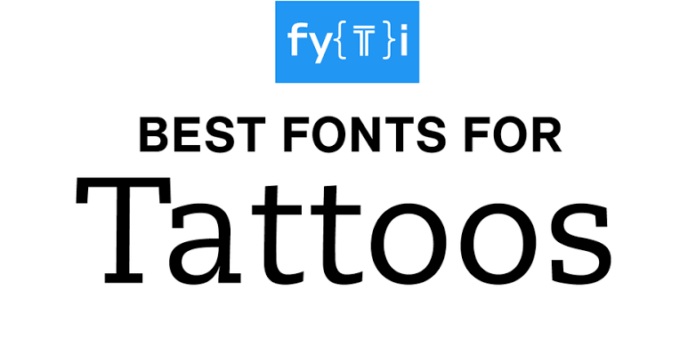Choosing the right font for your tattoo is a critical decision that impacts both the aesthetic and personal significance of your body art. Tattoos are permanent, and the font you select will be a defining feature of your design. This guide explores various font styles, their characteristics, and how to choose the best one for your tattoo.
Why Font Selection Matters for Tattoos:
The font you choose is more than just a stylistic choice; it can influence the legibility, emotional tone, and overall aesthetic of your tattoo by using Font Generator.
An ideal font enhances the tattoo’s message and ensures it remains clear and impactful over time.
Legibility and Readability
Legibility is paramount when choosing a font for your tattoo. A stylish font that looks good on paper might become a jumble of lines and curves when tattooed on your skin. Ensure the font you choose is readable and maintains its clarity even when scaled down.
Emotional and Aesthetic Impact
Different fonts evoke different emotions and styles. For instance, a script font might convey elegance, while a bold sans-serif font exudes modernity. The font should align with the emotional and visual tone of your tattoo.
Popular Font Styles for Tattoos:
1. Script Fonts:
Script fonts emulate handwritten text, offering a flowy and elegant appearance. They are ideal for names, quotes, or phrases where a personal touch is desired.
Pros:
- Adds a personal and elegant touch.
- Perfect for flowing and romantic designs.
Cons:
- Can be difficult to read if overly intricate.
- May not suit larger tattoos or less elaborate designs.
2. Serif Fonts:
Serif fonts feature small lines or extensions at the end of strokes. These fonts provide a classic and formal appearance, suitable for traditional or sophisticated tattoos.
Pros:
- Provides a timeless and professional look.
- Enhances readability, especially in larger tattoos.
Cons:
- Can appear too rigid or formal for casual designs.
- Might not suit modern or minimalist themes.
3. Sans-Serif Fonts:
Sans-serif fonts lack the small projecting features of serif fonts, offering a clean and modern look. They are versatile and often used in minimalist or contemporary designs.
Pros:
- Clean and modern appearance.
- Highly readable in various sizes.
Cons:
- May seem too plain for more decorative designs.
- Lacks the character of more ornate fonts.
4. Gothic Fonts:
Gothic fonts, also known as Blackletter or Old English fonts, are ornate and dramatic, making them suitable for medieval or bold designs.
Pros:
- Offers a dramatic and historical feel.
- Highly distinctive and eye-catching.
Cons:
- Can be difficult to read, especially in smaller sizes.
- May not suit all design themes or personal styles.
5. Modern Fonts:
Modern fonts feature geometric shapes and clean lines, making them ideal for sleek and contemporary tattoos.
Pros:
- Stylish and up-to-date.
- Works well with both large and small tattoos.
Cons:
- May lack the personality of more decorative fonts.
- Might not convey the same warmth as traditional styles.
Choosing the Right Font for Your Tattoo:
1. Reflect on Personal Significance
Choose a font that reflects the meaning behind your tattoo. Whether it’s a name, quote, or symbol, the font should enhance the significance of the design.
2. Consider Placement and Size
The location of your tattoo on your body will affect the font choice. For example, a detailed script font might work well on larger areas like the back, while a simpler sans-serif font might be better suited for smaller areas like the wrist.
3. Design Harmony
Ensure the font complements the overall design of your tattoo. It should blend seamlessly with other elements to create a cohesive look.
4. Consult Your Tattoo Artist
Your tattoo artist can offer valuable advice on how different fonts will look on your skin. They can suggest fonts that fit well with their style and technique.
FAQs:
How do I choose a font that will look good as a tattoo?
Selecting a font involves considering legibility, personal significance, and design harmony. Test different fonts to see how they fit with your tattoo design and consult with your tattoo artist for their professional opinion.
Are there fonts that are better suited for small tattoos?
Yes, simpler and cleaner fonts such as sans-serif or basic script fonts tend to work better for small tattoos. They maintain readability even in smaller sizes.
Can I use a custom or unique font for my tattoo?
Custom or unique fonts can add a personal touch to your tattoo. Just ensure that the font is readable and suits the overall design.
How do I ensure the font stays readable over time?
Choose a font that is clear and straightforward. Avoid overly intricate designs that might blur or fade. Discuss your font choice with your tattoo artist to ensure it will age well.
What if I’m not sure which font to choose?
If you’re unsure, consider working with a professional designer or your tattoo artist to experiment with different fonts and styles. They can help you visualize how various options will look on your skin.
Conclusion:
Choosing the right font for your tattoo is a critical step that affects both its appearance and meaning. By considering legibility, personal significance, and design harmony, you can select a font that enhances your tattoo and stands the test of time.


